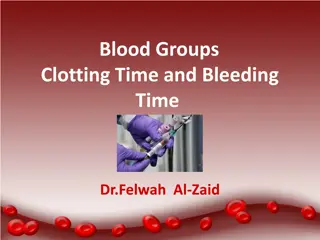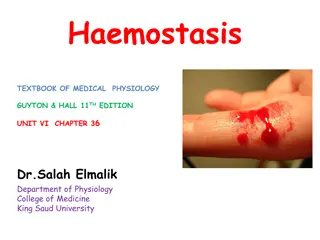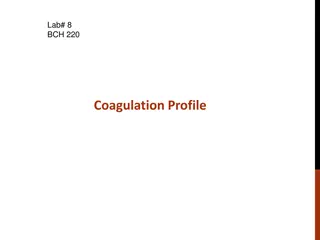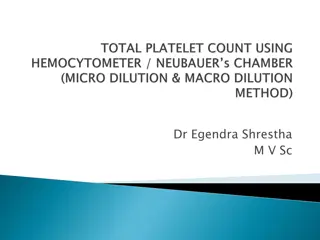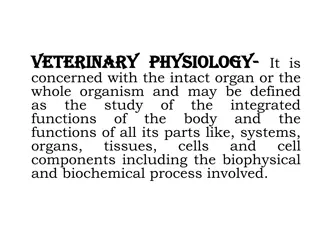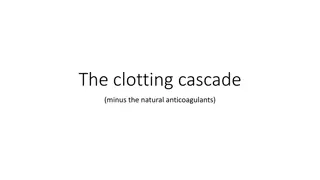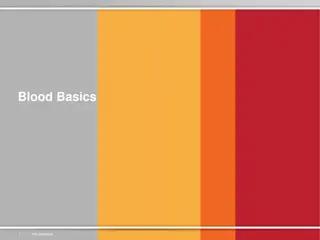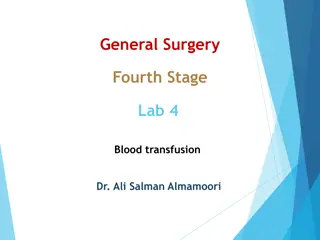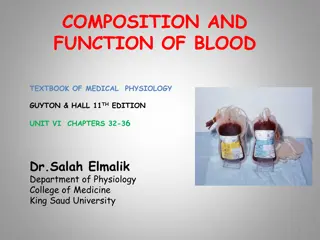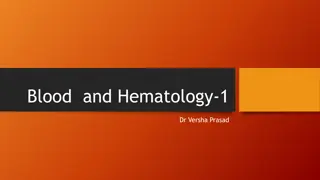Understanding Blood Clotting Factors in the Human Body
Blood clotting factors play a crucial role in the coagulation process to prevent excessive bleeding. Factors such as Fibrinogen (Factor-I), Prothrombin (Factor-II), Thromboplastin (Factor-III), Calcium Ions (Factor-IV), Labile Factor (Factor-V), and Stable Factor (Factor-VII) are essential for the cascade of events leading to clot formation. Each factor has a specific function and deficiency can lead to clotting disorders.
Download Presentation

Please find below an Image/Link to download the presentation.
The content on the website is provided AS IS for your information and personal use only. It may not be sold, licensed, or shared on other websites without obtaining consent from the author. Download presentation by click this link. If you encounter any issues during the download, it is possible that the publisher has removed the file from their server.
E N D
Presentation Transcript
Blood Clotting Factors Dr.Shashikant Dr.Shashikant R.Sitre Assistant Professor Department of Zoology R.Sitre N.S.Science and Arts College, Bhadrawati Dist.Chandapur 442902
BLOOD CLOTTING FACTORS (13) Factor I Factor II Factor III Factor IV Factor V Factor VI Factor VII Factor VIII Factor IX Factor X Factor-XI Factor-XII Factor-XIII
Factor-I ( Fibrinogen ) Fibrinogen is a plasma protein of high molecular weight. It takes part in blood clotting.
Factor-II (Prothrombin) Prothrombin is a glycoprotein synthesized in the liver. Vitamin K is essential for its formation. Inactive thrombin is converted into active thrombin in the presence of thromboplastin and accelerators and calcium ions. The amount of thrombin formed is proportional to the initial level of prothrombin. However its insufficient amount is always present in the circulating blood in connection with continuous latent microcoagulation. Prothrombin has the molecular weight about 69000.
Factor-III (Thromboplastin) It is a lipoprotein found in blood platelets and tissue cells. It is secreted in its inactive form called prothromboplastin in the tissues. Under the action of a powerful activator proconvertin contained in the plasma tissue, prothromboplastin is transformed into active thromboplastin.
Factor -IV (Calcium Ions) It is not directly involved in the reaction of thrombin formation but it is required for the formation of prothrombin activator and for the formation of insoluble fibrin clot.
Factor V (Labile factor) This factor is essential for conversion of prothrombin to thrombin by tissue extract and plasma factors. Factor V is absent from serum being consumed during blood clotting.
Factor VII (Stable factor) This factor is required for the formation of prothrombin activator by tissue extract and is present in serum as well as plasma as being not consumed during blood clotting. Its deficiency is rarely occurred but is frequenmtly induced by oral anticoagulated drugs of the coumarin type.
Factor VIII (Antihaemophilic Factor) This factor is required for the formation of prothrombin activator from blood constituents and is found absent from blood serum being consumed during blood clotting. The deficiency of this factor may cause haemophilia.
Factor IX (Christmas factor) This factor is also required for the formation of prothrombin activator from blood constituents. It is found in plasma and is activated during clotting so that the activity in serum is much greater than in plasma. The deficiency of this factor is associated with a congenital haemorrahagic state resembling haemophilia (Christmas disease).
Factor X (Stuart Power factor) This factor is found in plasma and serum and is responsible for haemorrhagic state in deficiency.
Factor XI- Plasma Thromboplastin Antecedent This factor is found in plasma and serum and is responsible for formation of prothrombin activator from blood constituents. Its deficiency causes a haemorrahagic state.
Factor XII (Hageman Factor) This factor is also found in plasma and serum and is required for the formation of prothrombin activator from blood constituents. In the deficiency of this factor blood clots very very slowly.
Factor XIII (Fibrin Stabilizing Factor) This is a plasma protein which causes polymerization of soluble fibrin to produce insoluble fibrin. Its deficiency causes haemorrahagic state.








